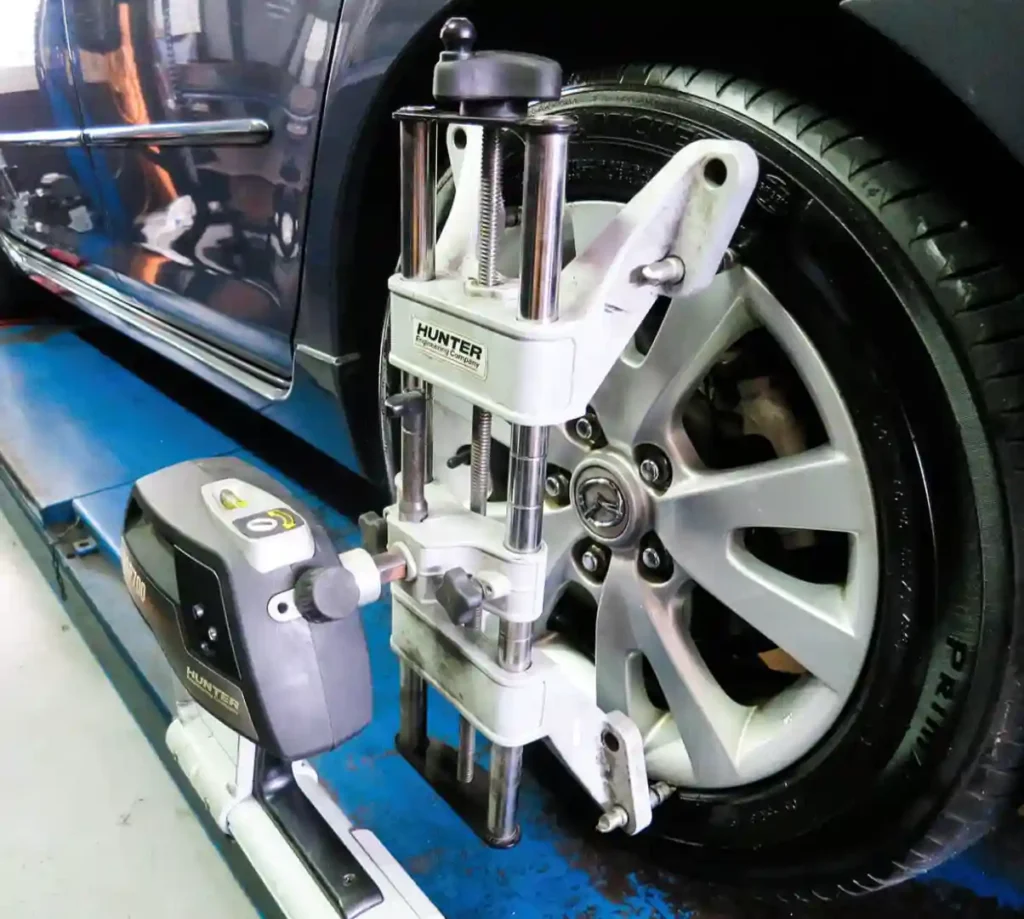Introduction to The Tire Maintenance
Tire maintenance is an often overlooked but crucial aspect of vehicle care. Proper tire maintenance not only ensures safety on the road but also significantly boosts fuel efficiency and extends the life of your tires. This comprehensive guide will delve into the essential practices of tire maintenance, provide valuable tips, and explain how these practices can save you money and enhance your driving experience.

Understanding Tire Basics
To effectively maintain your tires, it’s essential to understand the basics of tire types and specifications.
Types of Tires and Their Specific Uses
- All-Season Tires: Designed for a balanced performance in various weather conditions, making them suitable for year-round use.
- Performance Tires: Built for high-speed stability and improved handling, often used in sports cars.
- Off-Road Tires: Designed with deeper treads for better grip on unpaved surfaces, ideal for SUVs and trucks used in off-road conditions.
Reading Tire Specifications
Every tire has a series of numbers and letters on its sidewall that indicate its specifications:
- Size: Indicates the tire’s width, aspect ratio, and diameter.
- Load Rating: Shows the maximum load the tire can support.
- Speed Rating: Indicates the maximum speed the tire can handle.
Understanding these specifications helps in choosing the right tire for your vehicle and driving needs.
The Impact of Tire Maintenance on Fuel Efficiency
Proper tire maintenance plays a significant role in fuel efficiency. Underinflated tires create more rolling resistance, which forces the engine to work harder and consume more fuel. Studies have shown that keeping tires properly inflated can improve fuel efficiency by up to 3%. Conversely, overinflated tires can reduce traction and increase wear, negatively affecting fuel efficiency and safety.
Essential Tire Maintenance Tips

Regular Tire Inspections
Regularly inspecting your tires can prevent minor issues from becoming major problems. Look for:
- Cracks: These can indicate aging or damage.
- Bulges: Usually a sign of internal damage, potentially dangerous.
- Punctures: Look for nails, glass, or other sharp objects.
- Uneven Wear: Indicates alignment or suspension issues.

Tire Pressure Checks
Correct tire pressure is critical for safety, fuel efficiency, and tire longevity.
- How to Check Tire Pressure: Use a reliable tire pressure gauge to check the pressure when the tires are cold. Compare the reading with the manufacturer’s recommended levels.
- Recommended Tire Pressure Levels: Typically found in the owner’s manual or on a sticker inside the driver’s door.
- Impact of Overinflation and Underinflation:
- Overinflation can lead to a harsh ride and uneven wear.
- Underinflation causes increased rolling resistance, reducing fuel efficiency and causing more wear on the tire edges.
Tire Rotation
Rotating your tires ensures even wear and extends their lifespan.
- Importance of Regular Tire Rotation: Prevents uneven wear patterns that can lead to premature tire replacement.
- How Often to Rotate Tires: Typically every 5,000 to 8,000 miles or as recommended by your vehicle manufacturer.
- Benefits of Proper Tire Rotation: Improved handling, extended tire life, and better overall performance.
Wheel Alignment

Proper wheel alignment ensures that your tires wear evenly and your vehicle handles correctly.
- Signs of Misalignment: Vehicle pulling to one side, uneven tire wear, or a crooked steering wheel when driving straight.
- Benefits of Proper Wheel Alignment: Better handling, improved fuel efficiency, and longer tire life.
- How Often to Get Wheel Alignment Checked: Typically every 12,000 to 15,000 miles or if you notice any signs of misalignment.
Tire Balancing

Balancing your tires ensures a smooth ride and prevents premature wear.
- What is Tire Balancing and Why It’s Important: It involves adjusting the weight distribution around the tire to eliminate vibrations.
- Signs That Your Tires Need Balancing: Vibrations in the steering wheel, seat, or floorboard.
- Frequency of Tire Balancing: Every time you replace or rotate tires, or if you notice vibrations.
Tread depth is crucial for maintaining traction, especially in wet conditions. Monitoring your tire tread depth is an essential part of tire maintenance to ensure your safety on the road. To measure tread depth, you can use a tread depth gauge or perform the penny test. To do this, insert a penny into the tread with Lincoln’s head facing down. If you can see the top of his head, it’s time to replace the tire.
The legal tread depth limit in most regions is generally 2/32 of an inch. It is important to replace your tires when the tread is below this limit or if you notice significant wear patterns. Maintaining proper tread depth ensures that your tires can effectively grip the road, reducing the risk of hydroplaning and improving overall vehicle handling. Regularly checking your tread depth and replacing your tires as needed will help you drive safely and confidently in all weather conditions.
Common Tire Maintenance Mistakes to Avoid
Even with the best intentions, some common mistakes can negate your tire maintenance efforts:
- Neglecting Tire Pressure Checks: Regularly check and maintain the correct tire pressure.
- Ignoring Alignment and Balancing Issues: Address any signs of misalignment or imbalance promptly.
- Skipping Tire Rotations: Ensure regular tire rotations to promote even wear.
- Using Mismatched Tires: Always use matching tires for consistent performance and safety.
Choosing the right tires for your vehicle involves several important factors to ensure optimal performance, safety, and longevity. First, consider your driving conditions, vehicle type, and driving habits. For instance, if you frequently drive in wet or snowy conditions, all-season or winter tires may be the best choice. If you drive a high-performance vehicle, you might opt for tires designed for speed and handling.
When comparing different tire brands and their features, research reputable brands like Michelin, Bridgestone, Goodyear, and Continental. Each brand offers unique features, such as advanced tread designs, superior traction, and enhanced durability. Understanding these features can help you select tires that meet your specific needs.
Budget considerations are also crucial in the tire selection process. While it might be tempting to choose the least expensive option, it’s important to balance cost with quality and performance. Investing in higher-quality tires can lead to better fuel efficiency, longer tread life, and improved safety, ultimately providing better value in the long run. By carefully evaluating these factors, you can choose the right tires that fit your vehicle and driving needs.
Common Tire Maintenance Myths Debunked

Let’s address some common misconceptions about tire care:
- **Myth:** You only need to check tire pressure when they look low.
**Fact:** Tires can lose up to 50% of their air before they appear visually underinflated. - **Myth:** The pressure listed on the tire sidewall is the recommended pressure.
**Fact:** This is the maximum pressure the tire can hold, not the recommended pressure for your vehicle. - **Myth:** You should deflate your tires in summer to prevent over-inflation.
**Fact:** Always maintain the manufacturer’s recommended pressure, regardless of season. - **Myth:** Tire rotation isn’t necessary with all-wheel drive vehicles.
**Fact:** All vehicles benefit from regular tire rotation to ensure even wear.
When to Seek Professional Help
While many aspects of tire maintenance can be done at home, some situations call for professional assistance. If you notice uneven or rapid tire wear, steering wheel vibrations, or your vehicle pulling to one side, it’s time to consult an expert. Unusual noises from your tires, seasonal tire changes, and uncertainty about any aspect of tire maintenance are also reasons to seek professional help. Professional tire services can provide detailed inspections, precise alignments, and expert advice tailored to your specific vehicle and driving habits.
Conclusion
Proper tire maintenance is essential for safety, fuel efficiency, and longevity. By following the tips and practices outlined in this guide, you can ensure your tires are in optimal condition, saving you money and enhancing your driving experience. Prioritize tire care, and you’ll reap the benefits of a smoother, safer, and more efficient ride.
For more information, tools, and products related to tire maintenance, explore the following resources: tire maintenance tools and products like pressure gauges and tread depth gauges, recommended reading and references on tire care, and professional tire services. At Sandagiri Tire Kiribathgoda, our experts are ready to assist you with all your tire needs, ensuring your safety and peace of mind on the road. Visit us for expert advice and services tailored to your needs. Ensure your vehicle is equipped with the best tires for a safe and efficient journey. Contact us today to schedule your professional tire maintenance service.




